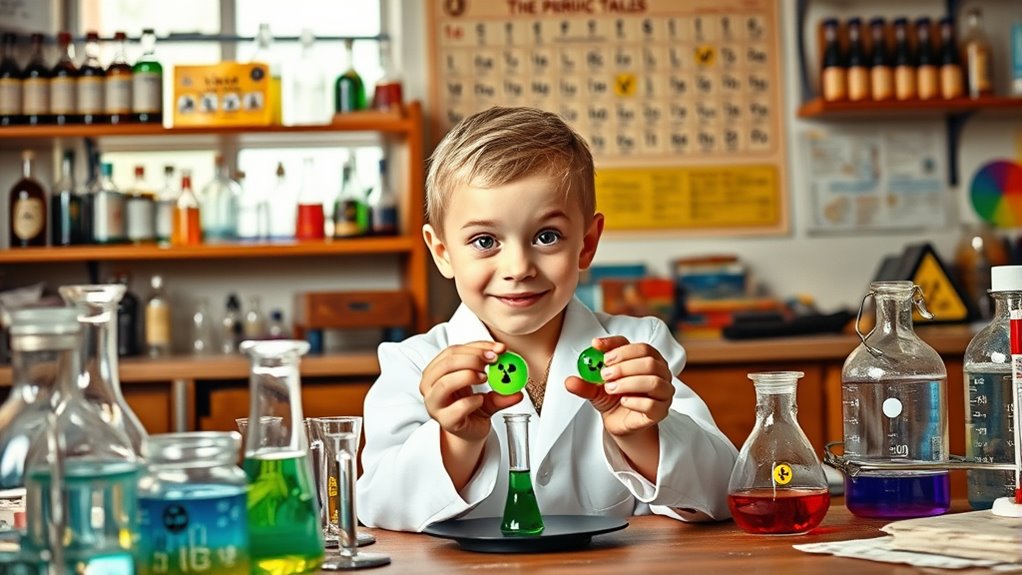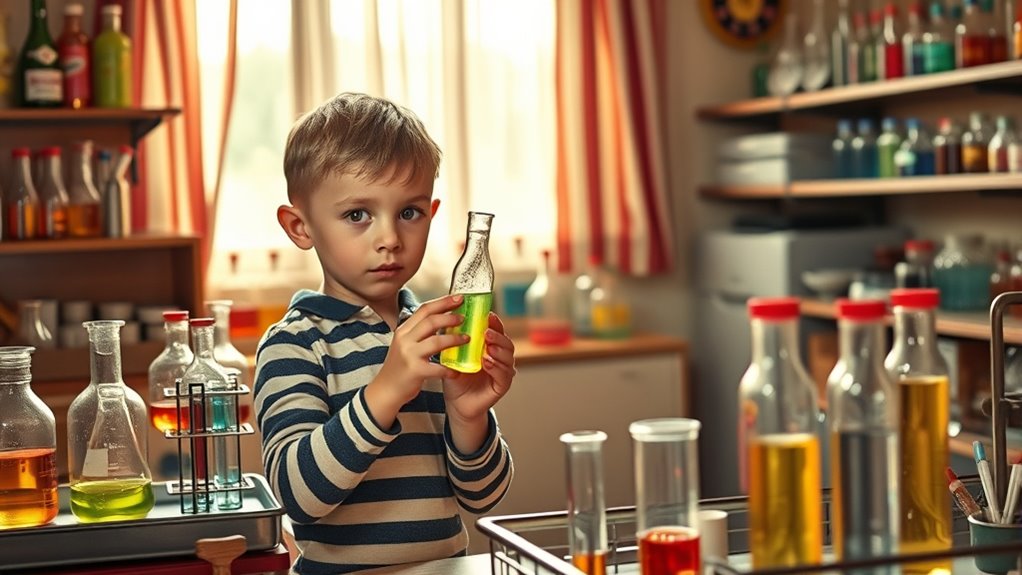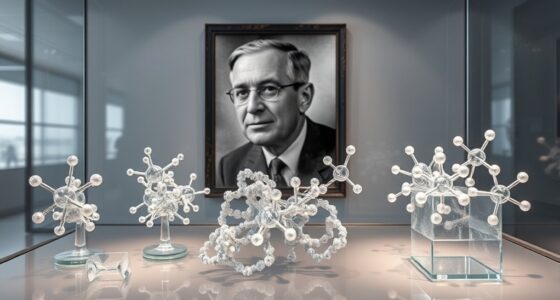In the 1950s, kids played with chemistry sets that often included radioactive materials like uranium salts, which seemed harmless and even exciting at the time. Many didn’t realize these substances emitted particles that could cause health issues over time. Parents saw these sets as educational fun, not dangers. Safety standards were minimal, and awareness about radiation risks was limited. If you keep exploring, you’ll uncover how this curious era risked childhood safety and shaped future regulations.
Key Takeaways
- 1950s chemistry sets included radioactive materials like uranium salts, encouraging children to experiment with glowing liquids and minerals.
- Safety regulations were minimal, and radioactive substances were marketed as harmless, leading to children handling dangerous materials unknowingly.
- Kids poured uranium salts into beakers, fascinated by their glowing effects, often without understanding the health risks involved.
- Parental and societal attitudes prioritized curiosity and education over safety, viewing radioactive materials as safe for children.
- Over time, increased awareness of radiation risks led to stricter safety standards and the redesign of modern chemistry sets.

Have you ever wondered what it was like to explore chemistry as a child in the 1950s? Back then, chemistry sets were more than just toys—they were gateways into the exciting world of scientific discovery. Kids ardently opened boxes filled with test tubes, chemicals, and even small samples of radioactive materials.
It might seem shocking today, but at the time, many of these sets included uranium salts or thorium compounds, which scientists used in experiments and even in early nuclear research. Kids thought they were just harmless ingredients for making slime or color-changing solutions, but those radioactive materials posed real safety concerns.
Back then, radioactive materials in kids’ chemistry sets posed serious safety concerns despite seeming harmless.
Back then, safety wasn’t a top priority. Manufacturers believed that handling radioactive substances was safe enough for children, and regulations were virtually nonexistent. Kids would pour uranium salts into their beakers, fascinated by the glowing green or yellow liquids, unaware of the potential radiation exposure.
Their parents, often uninformed about the risks, saw these sets as educational tools that sparked curiosity. The allure of radioactive materials overshadowed the dangers because the understanding of radiation’s harmful effects simply wasn’t widespread.
You might imagine the thrill of mixing chemicals and observing reactions, but what you wouldn’t have known then was that some of those materials emitted tiny amounts of radiation. While the risk of immediate harm was low, prolonged or careless exposure could have been dangerous. In fact, some children may have experienced radiation exposure without realizing it, adding a hidden risk to their scientific adventures.
The radioactive elements in the sets weren’t highly radioactive like nuclear fuel but still emitted particles that could cause cellular damage over time. Despite this, safety concerns were largely ignored. Manufacturers didn’t warn about the risks, and regulations on radioactive materials in consumer products were minimal.
As a result, children played with potentially hazardous substances without realizing the danger. This carefree approach to handling radioactive materials reflects a different era’s attitude toward scientific exploration. Furthermore, many of these sets lacked proper safety warnings, which contributed to the hazards children unknowingly faced.
The emphasis was on experimentation, discovery, and fun, often at the expense of safety. While many kids learned valuable lessons about chemistry, some may have unknowingly exposed themselves to unnecessary risks.
Over time, awareness grew, and safety protocols changed. Today, radioactive materials are tightly controlled, and chemistry sets have been redesigned to exclude dangerous substances. But in the 1950s, the chemistry set craze was a symbol of a time when curiosity trumped caution, and children played with radioactive materials as if they were just another part of their scientific adventures.
Frequently Asked Questions
Were Children Ever Harmed by Handling Radioactive Materials?
You might wonder if children were ever harmed by handling radioactive materials. During the 1950s, radioactive exposure from toys and experiments was a concern, but many kids weren’t fully aware of the risks.
Unfortunately, some experienced health issues later due to childhood exposure. Today, strict regulations prioritize childhood safety, minimizing such dangers.
It’s essential to remember how past practices highlight the importance of proper safety measures when dealing with radioactive materials.
How Did Safety Regulations Change After the 1950S?
Think of safety standards as a shield that keeps us secure; after the 1950s, regulations strengthened markedly. You’d notice more stringent regulatory reforms, demanding safer handling and disposal of radioactive materials. These changes aimed to prevent harm and protect public health.
Today, safety standards are tighter than ever, ensuring that children and adults alike can explore science without risking their well-being, transforming hazardous curiosity into safe discovery.
Were Any Children Diagnosed With Radiation Poisoning?
You might wonder if any children were diagnosed with radiation poisoning from early toy safety oversights. While there are no widespread reports, some kids likely experienced radioactive exposure from handling uranium-containing toys.
These incidents prompted stricter safety regulations, emphasizing proper toy safety and limiting radioactive materials in children’s products. Today, regulations prevent similar risks, ensuring children’s safety and reducing the chances of radiation-related health issues.
Did Toy Uranium Pose Long-Term Health Risks?
Think of toy uranium as a ticking time bomb hiding in plain sight. You might wonder if it posed long-term health risks, especially since kids handled it without much safety awareness.
Chemical exposure to uranium can be harmful over time, but the level in toy sets was generally low. Still, it highlights the importance of understanding safety and risks in childhood play, reminding us that curiosity shouldn’t come at health’s expense.
How Did Parents and Educators Respond to These Hazards?
You might wonder how parents and educators reacted to toy uranium’s dangers. Back then, parental ignorance often led to a lack of concern, as many didn’t realize the health risks involved.
Educational oversight was minimal, and safety standards were rare. Some adults dismissed fears, allowing the craze to continue.
It wasn’t until later that awareness grew, prompting calls for stricter regulations and better safety education for both parents and teachers.
Conclusion
Just like a wild garden bursting with unexpected surprises, the chemistry set craze of the 1950s ignited your curiosity and sense of adventure. Kids weren’t just playing; they were explorers charting a world of hidden elements and atomic wonders. It was a time when learning chemistry felt like revealing a secret treasure chest, filled with sparkling discoveries. Embrace that daring spirit, because sometimes, the most extraordinary adventures start with a simple set of curious hands.









